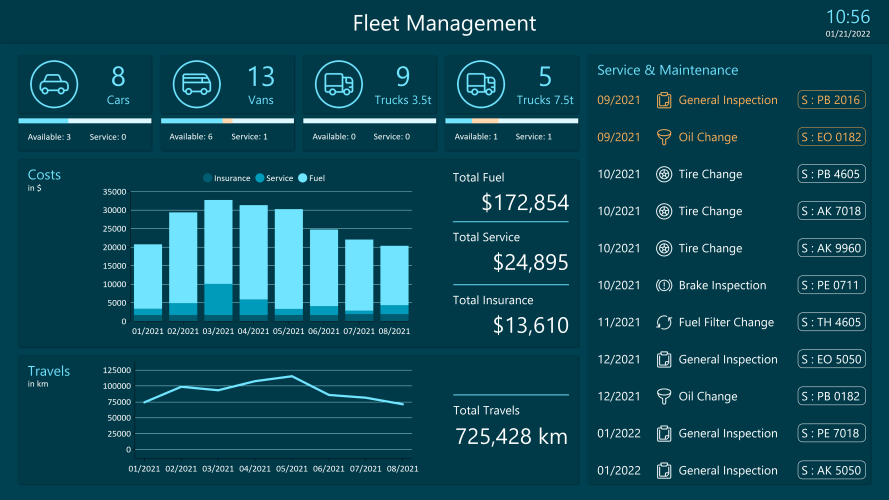What are the Benefits of a Fleet Management Dashboard?

Introduction
Fleet management is an important part of any business. It helps to ensure that your vehicles are in top condition and operating as efficiently as possible, while also providing drivers with the best possible customer service experience. However, there are many other aspects to fleet management that aren’t always so evident from looking at the vehicle itself. For example, a dashboard may show you how much fuel your vehicles have consumed over time, or the amount of CO2 emissions taken out by each vehicle when it’s not being used for its intended purpose (such as commuting).
Improved Vehicle Utilization
Vehicle utilization is an important factor for fleet management. As the name suggests, it’s the percentage of time each vehicle is being used. You can use this information to determine if your fleet needs more or fewer vehicles and how much they cost you to maintain.
A dashboard that displays vehicle utilization will show you how many hours a day your employees are driving their cars and trucks, as well as when those hours fall during the week or month (or year). This gives your insight into which types of vehicles are being used most often—and why! It’s important not just from an efficiency standpoint but also because it can help prevent accidents by making sure drivers aren’t overworking themselves at certain times during their shift periods.
Reduced Fuel Costs and Emissions
- Reduce fuel costs. A fleet management dashboard is a great way to reduce the cost of your fuel consumption and emissions. You can see how many miles your vehicles have driven, which means you can set targets for fuel efficiency or determine when it’s time for new tires or an oil change.
- Reduce carbon footprint by knowing where all your vehicles are at all times with an integrated GPS system that sends alerts when a vehicle is outside its normal range (if necessary).
Improved Driver Productivity and Safety
A fleet management dashboard can help you identify the drivers who are at risk of fatigue, distraction and performance issues. These drivers are often those who have been driving for a long time or have been on the road for only short periods of time. The dashboard will allow you to see how many hours each driver has been driving each day as well as their overall average speed and distance covered per trip. This information can be used by your company in order to provide more efficient services while also reducing potential safety issues with your employees’ health and well-being.
A dashboard allows managers to monitor exactly where they need improvement because it provides them with real-time information about what’s going on within their business right now—not just at one specific moment in time (which would be impossible).
Enhanced Customer Service Levels
Customer service is important, and the dashboard can help you to know what is going on with your fleet. But customer service is not just about the customer, it’s also about the drivers. You need to know what they are doing and how they are doing it.
Increased Profit Margins
The benefits of a fleet management dashboard are not only limited to the business. It can also be used by the driver or owner as well.
If you are a driver and want to improve your fuel efficiency, then having an online dashboard will help you track this metric over time and identify where improvements need to be made. If your truck has been involved in an accident recently, it might take several days before all of the damage is repaired or replaced, so knowing how much money was lost due to downtime will save costs down the road when repairs must be made instead of being done immediately after an accident occurs (which would normally cause additional downtime). With this information available at hand via your phone/tablet device’s internet connection—whether through an app like Fleet Management Dashboard or another type of service provider—you’ll know exactly what happened prior from start until completion of each repair job performed on behalf of one person who owns multiple trucks for himself/herself alone!
Dashboards can help to improve your fleet management practices.
Dashboards can help you to see the big picture. When you’re managing a fleet of vehicles, it’s easy to lose sight of how much work is going on behind the scenes. A dashboard provides an overview of your entire fleet performance, allowing drivers and managers alike to see how their drivers are doing. This allows them to make better decisions about which routes need improvement or maintenance and what types of tasks need further attention from other departments (such as IT).
Dashboards also provide useful information for drivers themselves: They allow them access not only into what their company has done within each department but also into previous months’ results so they know whether or not their individual efforts have been successful in meeting expectations set by management earlier on down this road towards success!
Conclusion
We hope you’ve been inspired by all of these benefits, and that they’ll help make the process of creating a dashboard easier for yourself. Regardless of which one you choose, we promise that once your dashboard is up-and-running, it will be an invaluable resource for both tracking and improving your fleet management practices.
Read More: Your Complete Manual for Picking a Travel Technology Provider in 2023 | TI Infotech Blog
